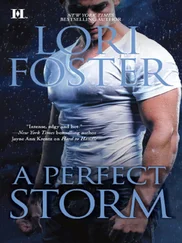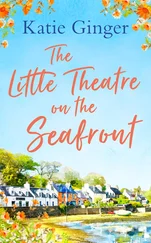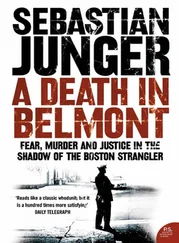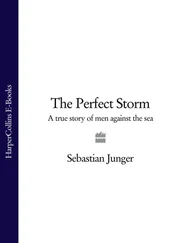Sebastian Junger - The Perfect Storm
Здесь есть возможность читать онлайн «Sebastian Junger - The Perfect Storm» — ознакомительный отрывок электронной книги совершенно бесплатно, а после прочтения отрывка купить полную версию. В некоторых случаях можно слушать аудио, скачать через торрент в формате fb2 и присутствует краткое содержание. Жанр: Триллер, Проза. Описание произведения, (предисловие) а так же отзывы посетителей доступны на портале библиотеки ЛибКат.
- Название:The Perfect Storm
- Автор:
- Жанр:
- Год:неизвестен
- ISBN:нет данных
- Рейтинг книги:3 / 5. Голосов: 1
-
Избранное:Добавить в избранное
- Отзывы:
-
Ваша оценка:
- 60
- 1
- 2
- 3
- 4
- 5
The Perfect Storm: краткое содержание, описание и аннотация
Предлагаем к чтению аннотацию, описание, краткое содержание или предисловие (зависит от того, что написал сам автор книги «The Perfect Storm»). Если вы не нашли необходимую информацию о книге — напишите в комментариях, мы постараемся отыскать её.
The Perfect Storm — читать онлайн ознакомительный отрывок
Ниже представлен текст книги, разбитый по страницам. Система сохранения места последней прочитанной страницы, позволяет с удобством читать онлайн бесплатно книгу «The Perfect Storm», без необходимости каждый раз заново искать на чём Вы остановились. Поставьте закладку, и сможете в любой момент перейти на страницу, на которой закончили чтение.
Интервал:
Закладка:
WITHIN weeks of the tragedy, families of the dead men get a letter from Bob Brown asking them to exonerate him from responsibility. The letter is polite and to the point, saying that the Andrea Gail was "tight, strong, fully manned, equipped and supplied, and in all respects seaworthy and fit for the service in which she was engaged." Unfortunately, she was also overwhelmed by the sea. For several of the bereaved—Jodi Tyne, Debra Murphy—this is the only letter they get from Bob Brown. He doesn't write a sympathy card, he doesn't offer financial help; he just sends a letter protecting himself from future legalities. It's possible that he's too shy, or embarrassed, to deal intimately with the bereaved, but they don't see it that way. They see Bob "Suicide" Brown as a businessman who has made hundreds of thousands of dollars off men like their husbands. To a woman, they decide to sue.
The deaths of the six Andrea Gail crew fall under the Death on the High Seas Act, a law passed by Congress in the early 1970s and then amended by the Supreme Court in 1990. A suit involving wrongful death on the high seas is limited to "pecuniary" loss, meaning the amount of money the deceased was earning for his dependents. Bobby Shatford, for example, was paying $325 a month in child support. Under the High Seas Act his ex-wife could—and does—sue Bob Brown for that money, but Ethel Shatford cannot sue. She has lost a son, not a legal provider, and has suffered no pecuniary loss.
The High Seas Act is a vestige of the hard-nosed English Common Law, which saw death at sea as an act of God that shipowners couldn't possibly be held liable for. Where would it end? How could they possibly do business? Had these men died in a logging accident, say, the family members could sue their employer for the loss of a loved one. But not on the high seas. On the high seas—defined as more than a marine league, or three miles, from shore—anything goes. The only way for Ethel Shatford to be compensated for the loss of her son would be to prove that Bobby's death had been exceptionally agonizing, or that Bob Brown had been negligent in his upkeep of the boat. Suffering, of course, is impossible to prove on a boat that disappears without a trace, but negligence is not. Negligence can be proven through repair records, expert witnesses, and the testimony of former crew.
Several weeks after the loss of the Andrea Gail, a Boston attorney named David Ansel agrees to represent the estates of Murphy, Moran, and Pierre in a wrongful death suit against Bob Brown. The other cases—including a wrongful death suit filed by Ethel Shatford—are handled by a Boston attorney who also specializes in maritime law.
Brown's name is already known to Ansel: Ten years earlier, Ansel's law firm represented the widow of the man washed out of the Sea Fever on Georges Bank. Now Ansel has to prove Brown negligent once again. The fact that Brown acted like every other boat owner in the sword fleet—eyeballing structural changes, overloading the whaleback, failing to carry out stability tests—isn't necessarily enough to clinch the case. Ansel packs his bags and heads to St.
Augustine, Florida, where, five years earlier, Bob Brown altered the lines of the Andrea Gail.
The shipyard, St. Augustine Trawlers, has been closed and sold by the I.R.S., but Ansel tracks down a former manager named Don Capo and asks him to give a deposition. Capo agrees. In the presence of a notary public and Bob Brown's attorney, David Ansel questions Capo about the alterations to the Andrea Gail:
To your knowledge, sir, was there a marine architect on board the vessel in Mr. Brown's employ?
I don't recall any.
Were there any measurements or tests or evaluations done to determine the amount of weight being added to the vessel?
No, sir.
Were there stability tests performed, either hydraulic or reclining?
No, sir.
So far, Capo's testimony has been damning. Brown altered the vessel without consulting a marine architect and then launched her without a single stability test. To anyone but a swordfisherman or a marine welder this would seem unusual—negligent, in fact—but it's not. In the fishing industry, it's as common as drunks in bars.
How would you characterize the Andrea Gail compared to other vessels? Ansel finally asks, hoping to put the last nail in the coffin. Capo doesn't hesitate.
Oh, top of the line.
Ansel's line of attack has been blunted, but he has other avenues. For starters he can talk to Doug Kosco, who walked off the boat with six hours to go because he got a bad feeling. What did Kosco know? Had anything happened on the previous trip? Kosco works for the A.P. Bell Fish Company in Cortez, Florida, and when he's not at sea he's usually crashing at one friend's apartment or another. He's a hard man to find. "It's—how can I put it—a nomadic existence," says Ansel. "These guys don't come home for dinner at five o'clock. They're gone three or four months at a time."
Ansel finally tracks Kosco down to his parents' house in Bradenton, but Kosco is uncooperative to the point of belligerence. He says that when he heard about the Andrea Gail he went into a three-month depression that cost him his job and nearly put him in the hospital. At one point Dale Murphy's parents invited him over to dinner but he couldn't deal with it; he never went. He'd known Murph as well as Bugsy and Billy, and all he could think was: That was supposed to have been me. Had Kosco gone on the trip, it's possible that he would've spent his last few moments pleading for his life—for this life, the one he's now leading. His wish was granted, in a sense, and it destroys him.
Ansel's case is fraying at the edges. He can't use Kosco's testimony because the man's too much of a mess; the Coast Guard says the EPIRB tested perfectly—although they won't release the report—and there's no hard evidence that the Andrea Gail was unstable. By the standards of the industry she was a seaworthy boat, fit for her task, and sank due to an act of God rather than any negligence on Bob Brown's part. The alterations to her hull may have helped her roll over, but they didn't cause it. She rolled over because she was in the middle of the Storm of the Century, and no judge is going to see it otherwise. Ansel's clients know that and decide to settle out of court. They probably won't get much—eighty or ninety thousand—but they won't run the risk of having Bob Brown completely exonerated.
Ansel starts negotiating a settlement, and the other suits are also settled in private. The relative stability of the Andrea Gail will never be debated in court.
ABOUT a year after the boat goes down, a man who looks exactly like Bobby Shatford walks into the Crow's Nest and orders a beer. The entire lineup of regulars at the bartop turn and stare. One of the bartenders is too shocked to speak. Ethel, who's just gotten off her shift, has seen the man before, in town, and explains to him why everyone's staring. You look just like my son who died last year, she says. There's a photo of him on the wall.
The man goes over and studies it. The photo shows Bobby in a t-shirt, hat, and sunglasses down on Fisherman's Wharf. His arms are folded, he's leaning a little to one side and smiling at the camera. It was taken on a day that he was walking around town with Chris, and he looks very happy. Three months later he'd be dead.
Jesus, if I sent this photo home to my mother she'd think it was me, the man says. She'd never know the difference.
Luckily the man is a carpenter, not a fisherman. If he were a fisherman, he'd drain his beer and settle onto a barstool and think things over a bit. People who work on boats have a hard time resisting the idea that certain ones among them are marked, and that they will be reclaimed by the sea. The spitting image of a man who drowned is a good candidate for that; so are all his shipmates. Jonah, of course, was marked, and his shipmates knew it. Murph was marked and told his mother so. Adam Randall was marked but had no idea; as far as he was concerned, he just had a couple of close calls. After the Andrea Gail went down he told his girlfriend, Chris Hansen, that while he was walking around on board he felt a cold wind on his skin and realized that no one on the crew was coming back. He didn't say anything to them, though, because on the waterfront that isn't done—you don't just tell six men you think they're going to drown. Everyone takes their chances, and either you drown or you don't.
Читать дальшеИнтервал:
Закладка:
Похожие книги на «The Perfect Storm»
Представляем Вашему вниманию похожие книги на «The Perfect Storm» списком для выбора. Мы отобрали схожую по названию и смыслу литературу в надежде предоставить читателям больше вариантов отыскать новые, интересные, ещё непрочитанные произведения.
Обсуждение, отзывы о книге «The Perfect Storm» и просто собственные мнения читателей. Оставьте ваши комментарии, напишите, что Вы думаете о произведении, его смысле или главных героях. Укажите что конкретно понравилось, а что нет, и почему Вы так считаете.












